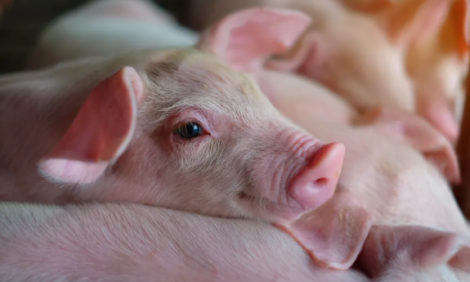



Multi-Sire, Multi-Mating - A Multitude of Sins
By Jane Jordan, ThePigSite Editor. In Denmark organic pork production is based on applying natural principles to animal husbandry techniques and management practices where and whenever possible. However, research at Aarhus University has shown that relying on natural matings when serving sows can be inefficient. Producers may do better to consider other methods.Standards for Danish organic pig production aim to allow near natural animal behaviour. Pigs are mostly housed outdoors and so natural mating is the preferred and more usual option. Artificial insemination is permitted and recent research now confirms that it may better for herds to adopt more controlled service procedures.
 |
| Natural mating is producing variable results in Denmark's organic pig herds. |
The outdoor multi-sire system, where the sows are grouped together in large paddocks and roam free with boars, is one example of a service system. It complies well with the organic ideals, but there is little knowledge about such system and just how effective - in terms of reproductive efficiency and economics - it is.
In the UK this multi-sire system is virtually obsolete. Few outdoor herds, organic or conventional, use it and those that do are managed carefully. Observation is critical, to ensure boars are not overworked and matings are successful. However, most producers have found using AI to be more efficient - it is less 'hit and miss' and the results are far more consistent.
Studies Pick Out Problems
Recent investigations by researches Kongsted and Hermansen, at the Faculty of Animal Science, Aarhus, looked at seven groups of sows. In total 47 sows and 31 boars were observed in a study on mating behavior in an outdoor multi-sire mating system. The subsequent reproductive performance was measured and conclusions drawn on efficiency.
The time of start of courtship, behavior and the cause of disruption if the courtship was terminated, were recorded each time a boar tried to mate with a sow. All aggressive interactions between the boars were also recorded to establish a boar ranking order.
Significant Impacts
The observations were significant and showed that numerous poor quality matings occurred. There was also a huge variation in the number of times sows were mated and evidence that some boars were overworked. All these factors are known to have a bearing on reproductive performance and also subsequent litter size.
Only 35 per cent of all copulations lasted two minutes or longer and 63 per cent of all copulations were disrupted, mainly by competitor boars. Also, the higher social status of the boar, then the more disruptive he was with other matings (p< 0.05).
The outcome of these studies showed an unacceptable variation in conception success. Only 71 per cent of all oestrus sows conceived, resulting in a pregnancy rate of 77 per cent of all mated sows.
A large inter-group variation in reproduction performance was also observed. This indicated scope for improvements. In some groups all sows showed oestrus and all sows conceived.
The researchers say that their findings indicate that improvements should be considered. The efficiency of service on many outdoor organic herds could be better.
Technology Available Outside
AI technology has moved on in recent years and the equipment now available is hygienic, easy to use and very effective. In the UK commercial outdoor herds - most of who are involved in premium, value-added and/or organic pork production - are using AI. They rely on the control it provides in terms of reproductive efficiency and the highly superior genetics it can provide to progeny.
For example, the 550-sow outdoor Levington herd in Suffolk, UK, has been using AI for many years. The herd is owned by breeding company Rattlerow Farms and produces parent breeding stock.
 |
| Using AI outdoors is possible and offers greater control at service |
Although the unit is not organic, it has production pressures as it is managed on a batch system and 83 sows must be served per batch to achieve a target of 70 farrowings. All matings are by AI and the farrowing rate is consistently over 90 per cent.
The herd started using the Automate AI system (also known as GEDIS®) in 2004. The hands-free system, developed by french breeding specialist Genes Diffusion, is particularly suited to outdoor herds because it is simple and ready to use. There are no bottles and catheters and no need to pre-warm the semen. The all-in one applicator and dose of semen also claims to be up to seven times faster than conventional AI methods and reduces operator error. The benefits are seen in farrowing rate and numbers born per litter. The applicator took three years to develop and almost 2.5 million doses are now sold in France each year.
AutoMate is slightly more expensive to buy per dose than conventional AI packages, but when you consider the time savings (per application) it is easily justified - as many producers using the system will testify!
Detection Essential
A number of boars do still run with Levington's weaned sows, mainly for stimulation. A batch system must achieve target numbers served if it is to achieve the correct number of farrowings. It would be impossible to do this using natural service in a dynamic system as it would place too much strain on the boars and so AI is the only viable option. Oestrus detection and observation is vital. Sows must be standing for any AI system to work efficiently.
Alternative Layout
Levington has changed its unit layout to accommodate AI. It uses a separate service radial comprising four paddocks - two for flushing sows and two for served sows. There are two central mating shelters with three pens. Sows are brought out of the flushing paddocks to be mated in a service pen. Here they have nose-to-nose contact with a boar while they are served.
After service they are released into the served sow paddocks where they can be observed. A few boars run with them, just in case there are any returns to service, but they are withdrawn at the end of the four-day service window. Any returns are marked and removed.
For the UK, AI outside has been revolutionary, and an incredible advance considering it was rarely seen on commercial units, indoor or out, 15 years ago. In the early 1990's fewer than 10 per cent of UK producers used AI and the industry lagged way behind its European competitors. However, economic pressure, disease challenges and some massive developments in AI technology have turned things around and for most outdoor herds AI has become the backbone of the operation. Herd performance on these units is comparable to their indoor counterparts and until the recent crisis, UK productivity and efficiency has been increasing year on year.
'The mating behavior and reproduction performance in a multi-sire mating system for pigs' - Kongsted AG, Hermansen JE. Department of Agroecology, Faculty of Agricultural Sciences, University of Aarhus, P.O. Box 50, DK-8830 Tjele, Denmark.
To view an abstract click here
For more information on the work at Aarhus University visit www.agrsci.org
April 2008








